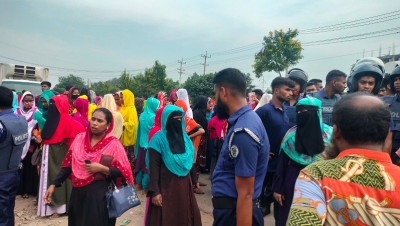 Photo: Bonik Barta
Photo: Bonik Barta Despite widespread unrest surrounding anti-discrimination
protests and the student-people uprising in July, the country’s exports
remained unaffected in the first month of fiscal year 2024-25. The month saw
considerable turmoil with consecutive fatalities leading to intense
demonstrations that paralyzed the nation. A curfew was imposed, and internet
services were shut down. Export activities were disrupted, and goods shipment
came to a standstill. Yet, these events did not impact the export statistics.
According to a report from Bangladesh Bank, exports grew by 2.91 percent during
the tumultuous month of July.
Bangladesh Bank released its ‘Major Economic Indicators:
Monthly Update’ report for August yesterday (Sunday, September 22). It showed
that in July, Bangladesh exported goods worth $3.82 billion to the global
market, compared to $3.71 billion in July of 2023, marking a 2.91 percent
growth in exports. Industry insiders, however, are skeptical of the credibility
of these growth figures, given the country’s chaotic situation. Nevertheless,
they are considering the fact that production was halted last year in July due
to the Eid holiday, which could explain the export increase.
Additionally, experts suggest that export disruption
existed for a minimal period in July this year. The increase in the cost of
imported raw materials also contributed to the final price of garments
exported. Moreover, the rise in value-added garments may have led to a higher
revenue flow, even with lower quantities of goods exported.
Fazlee Shamim Ehsan, Executive Vice President of the
Bangladesh Knitwear Manufacturers and Exporters Association (BKMEA), told Bonik
Barta, “Last year, production in July was lower due to the Eid holiday.
Naturally, we produced more in July this year compared to the same month last
year. Disruptions caused by the unrest only affected us for three or four days.
Accounting for this, we produced at least 10 percent more than last July.
Additionally, we saw an increase in the production of value-added garments. The
rise in the price of raw materials for these products has also contributed to
export growth. These factors likely explain the growth in exports.”
However, this business leader notes that despite these
factors, there remains doubt about the accuracy of the export statistics, given
the real-world situation. He emphasized the need to investigate the matter
further.
According to the central bank’s report, garment products
comprised the largest share of July exports. Knitwear exports amounted to
almost $1.73 billion, compared to $1.69 billion in July last year. This marks
an increase of $34.7 million or 2.05 percent.
In the woven garment sector, exports reached almost $1.45
billion in July 2024, compared to $1.39 billion in the same month last year.
This indicates a rise of $54.9 million or 3.94 percent.
Home textiles were the third-largest export item in July,
experiencing a 4.21 percent growth. Home textile exports stood at $54.5 million
in July 2024, compared to $52.3 million in July 2023.
Agricultural exports increased 11.23 percent in July 2024 to $80.2 million, up from $72.1 million in July 2023. However, products that recorded negative or declining growth in the first month of this fiscal year include jute and jute goods, engineering products, and chemical products. Exporters continue to demand accurate statistics, as they believe the figures published by the central bank do not align with the realities on the ground.






